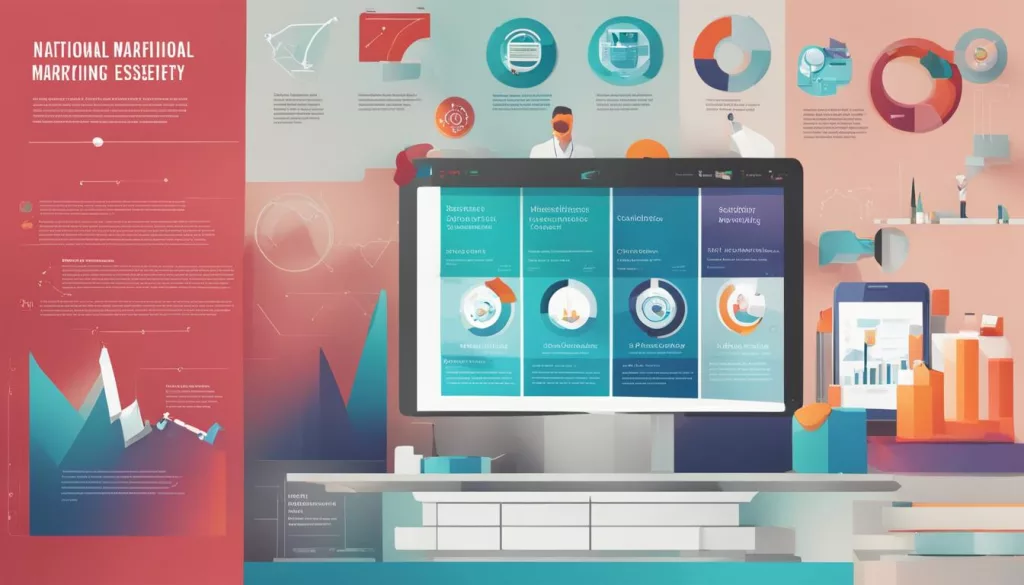Healthcare marketing trends are constantly evolving, and staying up to date with the latest trends is crucial for success in the healthcare industry. In this article, we will explore the top healthcare marketing trends for 2023, providing insights and strategies to help healthcare organizations navigate the digital landscape and engage with patients effectively.
Key Takeaways:
- Stay updated with the latest healthcare marketing trends for success in the industry.
- Optimize local SEO and Google Business Profiles to improve visibility and local search rankings.
- Utilize content marketing and long-form blog posts to establish thought leadership and capture organic traffic.
- Incorporate video marketing to provide a more engaging patient experience and build trust.
- Utilize Google Ads and programmatic display to reach and attract potential patients.
Local SEO Optimization
In the increasingly digital landscape of healthcare marketing, local SEO optimization plays a critical role in driving visibility and attracting patients. With the rise of online search and the importance of local search rankings, healthcare practices need to focus on optimizing their location pages and Google Business Profiles.
For practices with multiple locations, implementing a Franchise SEO model can ensure consistent branding and messaging across all locations while tailoring each location’s online presence to the specific needs and preferences of the local community. By optimizing location pages with relevant keywords, unique content, and accurate contact information, healthcare organizations can improve their chances of appearing in local search results.
A strong online presence is not complete without a well-optimized Google Business Profile. This profile acts as a virtual storefront, providing potential patients with essential information about a healthcare practice. Optimizing the Google Business Profile includes updating contact details, hours of operation, services offered, and even adding photos that showcase the practice’s facilities and healthcare professionals.
Physician profiles are another crucial element of local SEO optimization. By optimizing individual physician profile pages with relevant keywords, engaging biographies, and positive patient reviews, healthcare organizations can increase their visibility in search queries related to specific medical specialties or providers.
Benefits of Local SEO Optimization:
- Improved visibility in local search queries
- Increased website traffic and patient inquiries
- Enhanced brand credibility and trustworthiness
- Higher conversion rates with locally targeted leads
- Stronger connections with the local community
Optimizing location pages, Google Business Profiles, and physician profile pages are essential strategies for healthcare organizations to enhance their local SEO and attract patients in their target areas. By incorporating these tactics into their marketing efforts, healthcare practices can increase their online visibility and establish themselves as trusted providers in their local communities.
| Local SEO Optimization Strategies | Benefits |
|---|---|
| Implement Franchise SEO model | Consistent branding across multiple locations |
| Optimize location pages with relevant keywords and unique content | Higher visibility in local search results |
| Update and optimize Google Business Profiles | Improved online presence and credibility |
| Optimize physician profile pages with relevant keywords and positive patient reviews | Increase visibility in specialty-specific search queries |
National SEO and Content Marketing
National healthcare companies can significantly improve their online presence and drive organic traffic by prioritizing content marketing. Consistency and high-quality long-form content play a crucial role in capturing the attention of potential patients and boosting search rankings. By creating educational material and informative blog posts, healthcare organizations can establish trust and position themselves as thought leaders in the industry.
Developing a strong content marketing strategy that aligns with national SEO best practices is essential for maximizing visibility and attracting the right audience. This involves optimizing website structure, incorporating relevant keywords, and utilizing metadata effectively. Long-form blog posts not only provide in-depth information to readers but also enhance search engine optimization by offering valuable content that keeps visitors engaged on the website for longer periods.
Creating educational content that addresses common healthcare concerns, offers tips and advice, and highlights healthcare breakthroughs helps to build credibility and authority. It positions healthcare companies as trusted experts in their field and encourages patient engagement. Additionally, sharing informative content on social media platforms and through email newsletters can expand the reach and impact of content marketing efforts.
“Content marketing is a powerful tool for healthcare organizations to connect with their audience. By delivering valuable educational content through various channels, organizations can build trust, drive traffic, and establish themselves as leaders in the healthcare industry.”
Benefits of Educational Content and Long-Form Blog Posts
- Provides in-depth information to educate patients
- Establishes trust and credibility in the industry
- Enhances search engine visibility and organic traffic
- Attracts and engages the target audience
- Positions healthcare organizations as thought leaders
Examples of Educational Content
Healthcare organizations can create various forms of educational content to engage with their audience. Some examples include:
- Healthcare podcasts featuring expert interviews and discussions
- Video tutorials explaining medical procedures or offering health tips
- Infographics presenting statistical data or health-related information
- Whitepapers and e-books providing in-depth analysis and research findings

By leveraging the power of content marketing and optimizing it for national SEO, healthcare organizations can reach a wider audience, establish an authoritative presence, and drive organic traffic to their websites. Educational content and long-form blog posts play a vital role in attracting and engaging potential patients, ultimately contributing to the growth and success of healthcare organizations.
Video Marketing
Video marketing is a highly effective strategy for healthcare organizations in 2023. By incorporating video content into their marketing efforts, healthcare providers can engage with their audience on a more personal level and create a memorable experience for potential patients. Videos have the unique ability to convey information, evoke emotions, and build trust, making them an invaluable tool in healthcare marketing.
One of the key advantages of video marketing is its ability to provide an engaging patient experience. Videos allow healthcare organizations to showcase their facilities, introduce their staff, and explain complex medical procedures in a simplified manner. With compelling visuals and narratives, videos can educate and inform viewers, making them more likely to trust and choose a particular healthcare provider.
Healthcare video content can also be easily shared on social media platforms, increasing the reach and visibility of the organization. By creating informative and entertaining videos, healthcare providers can capture the attention of their target audience and encourage them to share the content with their friends and followers. This organic sharing can significantly boost brand awareness and attract new patients.
Educational videos, patient testimonials, and promotional videos are all effective types of healthcare video content. Educational videos can help patients better understand their medical conditions and treatment options, empowering them to make informed decisions about their healthcare. Patient testimonials, on the other hand, offer real-life stories of individuals who have had positive experiences with a particular healthcare provider, instilling confidence and trust in potential patients. Lastly, promotional videos can highlight the unique services and facilities offered by a healthcare organization, showcasing their competitive advantages and value proposition.
When creating video content, it is essential to prioritize patient engagement. Interactive elements such as quizzes, surveys, and call-to-action buttons can encourage viewers to actively participate in the video and take the next step towards becoming a patient. Additionally, incorporating captions and subtitles can improve accessibility and allow viewers to consume the content even in sound-sensitive environments.
Overall, video marketing is a powerful tool for healthcare organizations to connect with their audience and drive patient engagement. By leveraging the emotional impact of videos, healthcare providers can create a lasting impression, build trust, and ultimately attract and retain patients.
Google Ads and Programmatic Display
In 2023, when it comes to healthcare advertising, Google ads continue to be a popular choice for healthcare organizations. By leveraging the power of Google’s expansive reach and targeting capabilities, healthcare providers can effectively promote their services to a vast audience of potential patients.
Performance Max Campaigns are particularly effective in attracting patients. These campaigns optimize ad performance across various Google platforms, maximizing visibility and engagement. Through strategic keyword targeting, precise bidding, and ad format optimization, healthcare organizations can maximize the impact of their Google ad campaigns.
Video ads are another powerful tool in healthcare advertising. By creating compelling video content, healthcare providers can engage with their audience on a more personal and emotional level. Video ads can be shared across social media platforms, reaching a wider audience and driving brand awareness.
Programmatic display advertising also plays a key role in healthcare marketing strategies. This automated approach allows healthcare organizations to deliver targeted ads to their desired audience, based on demographics, interests, and online behavior. Programmatic display ensures that the right message is delivered to the right people at the right time, enhancing the effectiveness of healthcare advertising campaigns.
To illustrate the impact of Google ads and programmatic display in healthcare advertising, consider the following example:

A visual representation of programmatic display in healthcare advertising, displaying targeted ads to a diverse audience.
Insight:
By leveraging Google ads and programmatic display, healthcare organizations can effectively reach and engage with their target audience. Whether through Performance Max Campaigns or compelling video ads, these advertising strategies can drive brand awareness, attract new patients, and ultimately contribute to the growth and success of healthcare organizations.
Reputation Management
Reputation management plays a critical role in the success of healthcare organizations in 2023. Maintaining a positive online reputation enhances credibility and trust, influencing potential patients’ decisions. By leveraging Google Business Profiles and managing online reviews effectively, healthcare organizations can establish a strong reputation within their communities.
Google Business Profiles: Boosting Visibility and Trustworthiness
Google Business Profiles are a powerful tool for healthcare organizations to enhance their online presence and build trust with patients. With a well-optimized Google Business Profile, organizations can improve their local search rankings, making it easier for potential patients to find them. Additionally, a comprehensive and up-to-date profile provides essential information about services, location, and contact details, instilling confidence in patients and helping them make informed decisions.
To optimize your Google Business Profile:
- Ensure accurate and consistent business information, including name, address, and phone number (NAP data).
- Upload high-quality images that showcase your facility, staff, and services.
- Encourage patients to leave positive reviews on your profile, demonstrating your commitment to patient satisfaction.
- Regularly monitor and respond to reviews, addressing both positive feedback and constructive criticism professionally and promptly.
The Power of Online Reviews
Online reviews have a significant impact on a healthcare organization’s reputation and patient decision-making. Positive reviews build trust, while negative ones can undermine confidence and deter potential patients. Healthcare organizations must actively encourage patients to provide feedback and monitor online reviews across platforms.
Implementing a dedicated program to gather new reviews can help healthcare organizations generate a steady stream of positive feedback. Proactively reaching out to satisfied patients and requesting their review not only strengthens the organization’s reputation but also provides valuable social proof for potential patients.
“Having a strong online reputation is crucial in today’s digital world. Positive patient reviews and an active engagement strategy illustrate our commitment to excellence and reassure prospective patients that they will receive high-quality care.”
However, negative reviews cannot be ignored. Responding professionally to negative feedback shows accountability and a commitment to addressing patients’ concerns. By empathetically addressing the issue and offering solutions publicly, healthcare organizations can demonstrate their dedication to improving patient experiences and mitigating potential reputational damage.
Remember, reputation management is an ongoing process, and feedback from patients provides valuable insights for organizational growth and improvement. By consistently monitoring and managing online reviews, healthcare organizations can build and maintain a positive online reputation.
| Benefits | Description |
|---|---|
| Increased Credibility | A strong online reputation enhances credibility and instills trust in potential patients, increasing the likelihood of choosing your healthcare organization. |
| Competitive Advantage | A positive online reputation gives you an edge over competitors, attracting more patients and establishing your organization as a trusted healthcare provider. |
| Greater Patient Engagement | Positive patient reviews and engagement demonstrate your commitment to patient satisfaction, fostering stronger patient relationships and loyalty. |
| Better Local Search Visibility | Well-managed online reviews and an optimized Google Business Profile improve your local search rankings, making it easier for potential patients to find your organization. |
Personalization and Patient Engagement
In today’s healthcare marketing landscape, personalization has become increasingly important. Tailoring marketing efforts to individual patients can provide a more personalized and engaging experience, ultimately leading to improved patient satisfaction and retention.
One effective way to personalize marketing is by providing personalized recommendations to patients. By leveraging data and understanding patients’ preferences and needs, healthcare organizations can deliver targeted recommendations and relevant content, ensuring patients receive the information and support they require for their unique healthcare journey.
Creating online patient communities is another powerful strategy for personalization and patient engagement. These communities allow patients to connect with others who share similar health concerns or experiences, fostering a sense of belonging and support. Healthcare organizations can facilitate these communities by providing platforms for patients to interact, share knowledge, and offer peer support.
Patient engagement is crucial throughout the entire healthcare journey. By actively involving patients in their own care and decision-making processes, healthcare organizations can empower patients to take charge of their health, leading to better health outcomes. Through personalized communication, educational resources, and shared decision-making tools, patient engagement can be effectively enhanced.
To illustrate the importance of personalization and patient engagement, consider the following statistics:
- 71% of patients are more likely to choose a healthcare provider that offers personalized services.
- 80% of patients are willing to share personal health data in exchange for personalized healthcare experiences.
- Patient engagement can lead to a 20% reduction in hospital readmissions.
“Personalization is the key to building strong patient relationships and delivering exceptional healthcare experiences. By tailoring our marketing efforts to meet the unique needs of each patient, we can create a more personalized and effective communication channel.”
– Dr. Sarah Miller, Chief Marketing Officer at HealthyCare Services
Patient Communication and Education
Effective patient communication is vital for personalized marketing and patient engagement. Healthcare organizations can utilize various channels, such as email newsletters, SMS messages, or patient portals, to deliver personalized communications. These communications can include appointment reminders, health tips, and customized educational resources catered to each patient’s specific condition or treatment plan.
By providing patients with easily accessible and personalized educational content, healthcare organizations can empower patients to actively participate in their healthcare decisions. Educational resources can be in the form of articles, videos, or interactive tools that address patients’ specific concerns and provide them with the knowledge they need to make informed decisions about their health.
Benefits of Personalization and Patient Engagement
Implementing personalized marketing and patient engagement strategies can yield numerous benefits for both patients and healthcare organizations:
- Improved patient satisfaction and loyalty
- Enhanced patient trust and confidence in healthcare providers
- Increased patient adherence to treatment plans and medication
- Reduced healthcare costs through better health outcomes
- Higher patient engagement leading to improved health education and self-management
As healthcare continues to evolve, the focus on personalized marketing and patient engagement will only intensify. Healthcare organizations that prioritize personalization and foster patient engagement throughout the healthcare journey are well-positioned to deliver exceptional customer experiences and drive positive health outcomes.
Expanded Marketing Scope
Healthcare organizations need to embrace an expanded marketing scope in order to effectively reach and engage with patients in 2023. Traditional channels alone are no longer sufficient in the digital era. To stay relevant and competitive, healthcare organizations must utilize omnichannel marketing strategies, leverage the power of social media, and incorporate video-based content into their marketing efforts.
Omnichannel Marketing
Omnichannel marketing focuses on delivering a seamless and integrated experience to patients across various channels and touchpoints. It involves creating a cohesive brand presence and delivering consistent messaging across online and offline platforms. By implementing omnichannel marketing strategies, healthcare organizations can ensure that their target audience receives a unified and personalized experience, regardless of the platform or device they use.
Social Media Marketing
Social media platforms have become integral to the marketing landscape. They provide healthcare organizations with a direct and interactive channel to engage with patients, share valuable information, and build brand awareness. By utilizing social media marketing techniques such as targeted advertising, influencer partnerships, and community engagement, healthcare organizations can effectively reach and connect with their target audience.
“Social media platforms have become integral to the marketing landscape. They provide healthcare organizations with a direct and interactive channel to engage with patients, share valuable information, and build brand awareness.”
Developing a robust social media strategy involves identifying the appropriate platforms for a specific target audience and creating engaging and shareable content. Incorporating patient testimonials, educational content, and behind-the-scenes glimpses can help humanize the brand and establish trust with potential patients.
Video-Based Content
Video-based content has emerged as a powerful tool for healthcare marketing. Videos enable healthcare organizations to communicate complex information in a visual and engaging manner, establishing an emotional connection with viewers. Whether it’s educational videos, patient testimonials, or virtual tours of facilities, video-based content can help healthcare organizations effectively showcase their services and expertise.
Additionally, videos can be easily shared and spread through social media platforms, amplifying the reach and impact of healthcare marketing efforts. By incorporating video-based content into their marketing strategy, healthcare organizations can capture and retain the attention of their target audience.
| Benefits of Expanded Marketing Scope: |
|---|
| Enhanced brand visibility and awareness |
| Improved patient engagement and relationships |
| Effective targeting and personalized messaging |
| Increased reach and access to a wider audience |
| Opportunity to showcase expertise and services |
Conclusion
Staying ahead of the latest healthcare marketing trends is crucial for success in the industry. In 2023, healthcare organizations should prioritize local and national SEO optimization to improve their visibility in search rankings and attract potential patients. By optimizing location pages and Google Business Profiles, healthcare practices can enhance their online presence and local search performance.
Video marketing is another key strategy for engaging with patients. Utilizing educational videos, patient testimonials, and promotional content can create a more personal and engaging patient experience. Videos can be easily shared on social media platforms, expanding the reach of healthcare organizations and increasing patient engagement.
Reputation management is essential in building trust and credibility. By actively managing online reviews and maintaining a strong Google Business Profile, healthcare organizations can enhance their online reputation and attract more patients. Implementing personalized marketing strategies and prioritizing patient engagement throughout the healthcare journey will contribute to improved patient satisfaction and retention.
Lastly, healthcare organizations must expand their marketing scope to capitalize on the potential of social media and video-based content. Utilizing an omnichannel marketing approach and creating consistent video content can help healthcare organizations reach and engage with a wider audience.
By adapting to evolving consumer expectations and prioritizing innovative healthcare marketing strategies, organizations can navigate the digital landscape successfully and thrive in the competitive healthcare industry in 2023 and beyond.
FAQ
What are some healthcare marketing trends for 2023?
Some healthcare marketing trends for 2023 include local SEO optimization, national SEO and content marketing, video marketing, Google Ads and programmatic display, reputation management, personalization and patient engagement, and expanded marketing scope.
How can healthcare organizations optimize local SEO?
Healthcare organizations can optimize local SEO by optimizing their location pages and Google Business Profiles, implementing a Franchise SEO model, and optimizing physician profile pages.
What strategies should national healthcare companies prioritize for SEO and content marketing?
National healthcare companies should prioritize content marketing by focusing on consistency and high-quality long-form content. Educational material and informative blog posts can help capture the attention of potential patients and establish trust.
How can healthcare organizations leverage video marketing in 2023?
Video marketing is highly effective in healthcare marketing. Healthcare organizations can create educational videos, patient testimonials, and promotional videos to convey information and build trust with potential patients. Videos can be easily shared on social media platforms.
What are some effective healthcare advertising strategies for 2023?
Google ads, particularly Performance Max Campaigns and video ads, are popular healthcare advertising trends in 2023. Programmatic display is also important for delivering targeted ads to the desired audience.
Why is reputation management important for healthcare organizations?
Reputation management is important for healthcare organizations as positive online reviews and a strong Google Business Profile contribute to credibility and trustworthiness. Implementing a dedicated program to gather new reviews and responding to both positive and negative reviews can significantly impact an organization’s online reputation.
How can healthcare organizations personalize their marketing efforts?
Healthcare organizations can personalize their marketing efforts by tailoring them to individual patients, providing personalized recommendations, and creating online patient communities. This can enhance the patient experience and build trust.
How can healthcare organizations expand their marketing efforts beyond traditional channels?
Healthcare organizations can expand their marketing efforts beyond traditional channels by utilizing social media platforms and creating video-based content. Showcasing providers and services through videos and maintaining a consistent presence on social media can help attract and retain patients.
Why is it important for healthcare organizations to stay ahead of marketing trends?
It is important for healthcare organizations to stay ahead of marketing trends to effectively navigate the digital landscape and attract, engage, and retain patients. Innovating marketing strategies and adapting to evolving consumer expectations is key to staying competitive in the healthcare industry.


